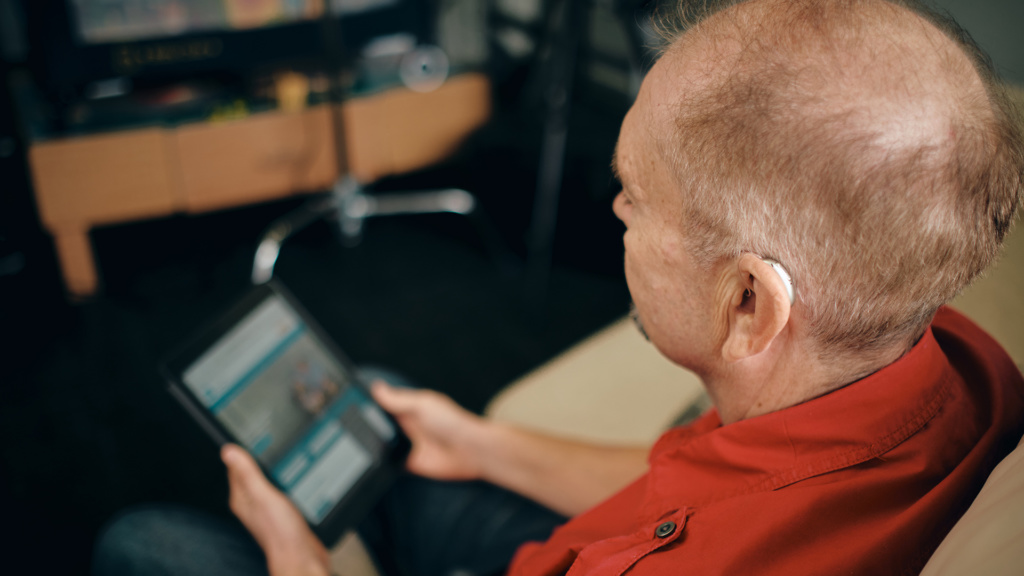To make sure you’re getting the most out of your hearing aids, it’s important to keep them clean and regularly maintained.
Quick care tips for hearing aids
Check out these easy general tips for cleaning your hearing aids:
Clean hearing aids helps to avoid a grimy build-up. Each night, get into the habit of removing soft wax using a tissue or gentle, dry cloth. Ensure you’re holding your hearing aid over a soft surface to minimise damage if you accidentally drop it!
Check the wax filters. If you’ve noticed a dull sound quality to your hearing aids, it might be a sign of an issue with the wax filters. Make sure the filters aren’t blocked with ear wax to ensure you’re not getting reduced sound, and clean or replace the wax filters as required.
Use your cleaning brush which comes with your hearing aids to give the microphone ports a clean, which helps to remove any build-up of dust or dry skin.
Keep your hearing aids dry. Read about what to do if you do get them wet.
See your audiologist regularly for reviews – at Hear and Say, we recommend every six months.

Do hearing aids need to be professionally cleaned?
By ensuring you have clean hearing aids regularly, you will help maintain the condition of your hearing aids long term. Like any technology, sometimes professional cleaning is required. How regularly you need to have your hearing aids professionally cleaned will vary from person to person. It will also be determined by the style of the hearing aid (for example, BTE hearing aid) and how quickly things like earwax, sweat and dirt build up. When you attend your regular audiology appointment, the audiologist will be able to advise on how regularly you should have your hearing aids cleaned.
Can I clean my own hearing aid?
While the deep cleaning of hearing aids should be left to your hearing care professional, who know how to properly clean them, there certainly are things that you can do at home. See our five quick tips above for details on how to clean your hearing aids.
Hearing aid cleaning tools
Hearing aid cleaning kits contain useful tools, inclusive of a small brush and an ear wax pick. These specially designed cleaning brushes and picks should be gently used for thorough cleaning of your hearing aids, avoid using your own, makeshift tools as this could cause damage. A soft cloth is also useful to have for wiping down and cleaning hearing aids. Cleaning kits and cloths can be purchased online, or ask your audiologist for advice on where to purchase these tools if you’re unsure. A hearing aid drying box can also be a useful tool for drying and cleaning hearing aids, using air and heat to do so.

How often do clearing aids need to be cleaned?
Wiping down your hearing aids with a soft cloth before bed each night is recommended. It is also a good idea to do an at-home clean every one to two weeks. The regularity of professional cleans will vary from person to person, your audiologist will be able to guide you on this.

How to clean an in the ear hearing aid
For hearing aids that sit in the ear (ITE hearing aids), here are a few cleaning tips:
Remove wax and dirt build up from the openings of the hearing device, clean the microphone ports and battery compartment with a soft brush. Face the opening you are cleaning downwards, this will allow loose particles to fall out of the hearing aid.
Use the wax pick from your cleaning kit to gently remove any further wax or dirt.
Gently wipe the device with a clean, soft, dry cloth.
How to clean a behind the ear hearing aid
Here are some tips to clean hearing aids that sit behind the ear (BTE hearing aids):
Remove any wax, dirt or debris from the behind the ear hearing aid with a soft brush and cloth.
If relevant, remove the earmold from the hook – wipe daily and soak in warm, soapy water once a week to help prevent discolouration. Ensure the moulds are completely dry before using them and avoid using alcohol or other chemicals.


How to clean a receiver-in-canal hearing aid
Here are some quick tips on how to clean your receiver-in-canal hearing aid (RIC hearing aid):
Wipe down the surface with a dry, soft, cloth.
Using a soft hearing aid brush, remove dirt from the sound outlet.
Gently clean the openings of the hearing aid, use the brush to remove any dirt or dust.
Change the wax filter if needed (if it’s discoloured, dirty or there is wax that can’t be removed).
How do I clean the wax out of my hearing aid?
Use the tools supplied with your hearing aids. Wipe the outside surface with a soft dry cloth. Use the brush provided to brush off any wax. If you have an ear mould remove it from the ear hook and use an air blower to push wax out of the tubing. Ask your audiologist to demonstrate if you are unsure.
Can you use alcohol wipes on hearing aids?
Use the tools supplied with your hearing aids. Wipe the outside surface with a soft dry cloth. Use the brush provided to brush off any wax. If you have an ear mould remove it from the ear hook and use an air blower to push wax out of the tubing. Ask your audiologist to demonstrate if you are unsure.
Can hearing aids be rinsed with water?
Avoid getting your hearing aids wet, use a soft dry cloth and special cleaning tools to clean them. If you accidently get your hearing aids wet, there are several things you can do to look after them, click here to learn more.









